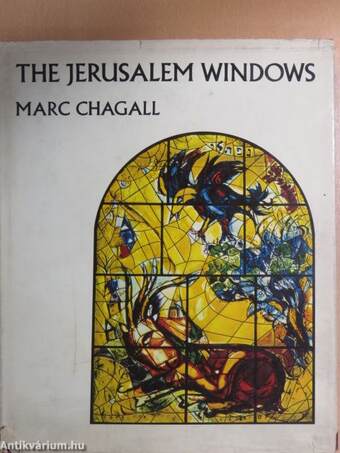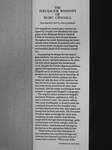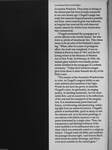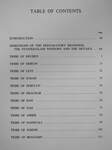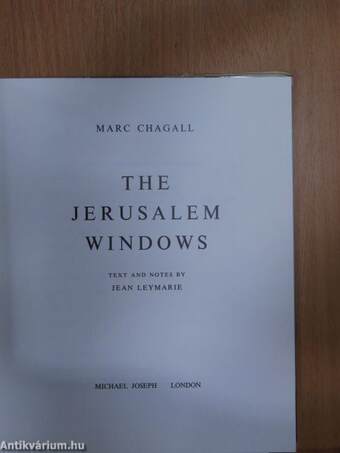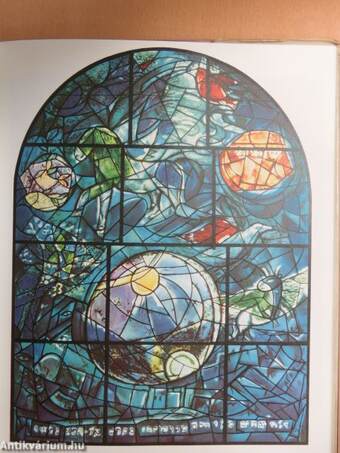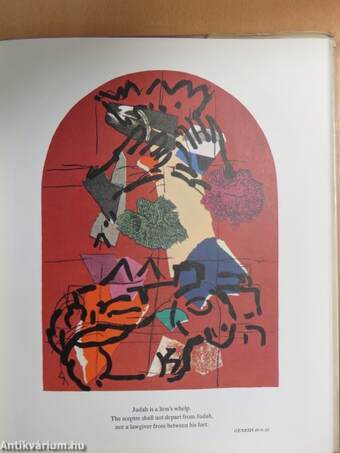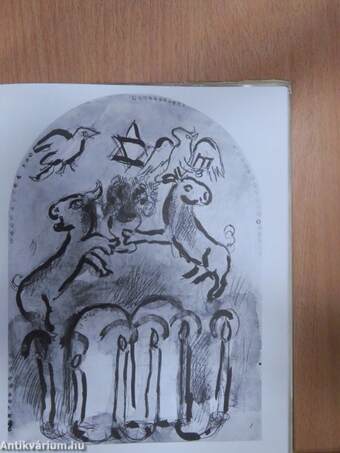1.067.288
kiadvánnyal nyújtjuk Magyarország legnagyobb antikvár könyv-kínálatát

VISSZA
A TETEJÉRE
JAVASLATOKÉszre-
vételek
The Jerusalem Windows
| Kiadó: | Michael Joseph Limited |
|---|---|
| Kiadás helye: | London |
| Kiadás éve: | |
| Kötés típusa: | Vászon |
| Oldalszám: | 119 oldal |
| Sorozatcím: | |
| Kötetszám: | |
| Nyelv: | Angol |
| Méret: | 27 cm x 22 cm |
| ISBN: | |
| Megjegyzés: | Színes és fekete-fehér reprodukciókkal. |
naponta értesítjük a beérkező friss
kiadványokról
naponta értesítjük a beérkező friss
kiadványokról
Előszó
TovábbFülszöveg
THE
JERUSALEM WINDOWS OF
MARC CHAGALL
Introductory text by Jean Ley marie
The magnificent stained-glass windows designed by Chagall, now installed in the synagogue of the Hadassah-Hebrew Medical Center in Jerusalem, have become famous throughout the world. Symbolizing the twelve ancient tribes of Israel, in luminous color, they are without doubt among the most inspiring and beautiful pieces of all twentieth-century art.
In preparing his designs for the stained-glass windows, the artist never lost sight of the poetry, fervor, and faith inherent in the Biblical texts which inspired this monumental work. Despite the Jewish religious prohibition against the representation of human forms, Chagall's art is, as always, a truly human expression of a vision that can be shared by all.
This splendid volume explains and illustrates not only the story of the windows but also the story of their creation. An introductory essay by the noted French critic, Jean Leymarie, tells the reader... Tovább
Fülszöveg
THE
JERUSALEM WINDOWS OF
MARC CHAGALL
Introductory text by Jean Ley marie
The magnificent stained-glass windows designed by Chagall, now installed in the synagogue of the Hadassah-Hebrew Medical Center in Jerusalem, have become famous throughout the world. Symbolizing the twelve ancient tribes of Israel, in luminous color, they are without doubt among the most inspiring and beautiful pieces of all twentieth-century art.
In preparing his designs for the stained-glass windows, the artist never lost sight of the poetry, fervor, and faith inherent in the Biblical texts which inspired this monumental work. Despite the Jewish religious prohibition against the representation of human forms, Chagall's art is, as always, a truly human expression of a vision that can be shared by all.
This splendid volume explains and illustrates not only the story of the windows but also the story of their creation. An introductory essay by the noted French critic, Jean Leymarie, tells the reader everything he needs to know to appreciate Chagall's iconography.
The original edition devoted to Chagall's Jerusalem Windows, published in 1962, is now a collector's item. The present edition, with some modification, is issued to meet the continued demand for this beautiful work. Lavishly illustrated with sixty color plates and twenty-four in black and white. The Jerusalem Windows takes us through the visual metamorphoses of each window, from the first rough sketch through finished drawings, paint, colored paper and textile collages, to the finished window. And facing each full page reproduction is the appropriate Biblical text.
"Great works of art defy limitations of time and place, but sometimes strange combinations are required to produce such art," writes Jean Leymarie. "This is true of the
(continued on back flap)
(continued from front flap) Jerusalem Windows. They seem to belong to the distant past but were actually conceived in our own atomic age. Chagall's magic has made this unusual temporal paradox possible, and Zion, where stained glass was unknown, at long last has received the well-deserved mystic raiment for which it has waited since time immemorial.
"Chagall envisioned the synagogue as 'a crown offered to the Jewish Queen,' the windows as jewels of translucent fire. This vision seems to be an echo of the Psalmist's rejoicing." When, after two years of prodigious effort, the work was completed, it was exhibited in Paris in June of 1961 and the following winter at the Museum of Modem Art in New York. In February of 1962, the stained-glass windows were finally permanently installed in the synagogue in a solemn ceremony. "Today their luminous images glow from dawn to dusk beneath the sky of the Holy Land____
"The essence of the Jerusalem Windows lies in color, in Chagall's magical ability to animate material and transform it into light. Words do not have the power to describe Chagall's color, its spirituality, its singing quaUty, its dazzling luminosity, its ever more subtle flow, and its sensitivity to the inflections of the soul and the transports of the imagination. It is simultaneously jewel-hard and foamy, reverberating and penetrating, radiating light from an unknown interior. Chagall's palette is inexhaustible, quick in sharp or subtle contrasts and, as in the latest paintings, it can enliven with infinite nuances a vast expanse dominated by a single color. Thus, the transparency and flashing brilliance of his color enabled it to be sublimated into a medium which was eminently suited to a religious subject. 'Chagall reads the Bible and suddenly the passages become light,' said Gaston Bach-elard about the earlier drawings, and this is even more manifest in the stained glass." Vissza
Témakörök
- Idegennyelv > Idegennyelvű könyvek > Angol > Művészetek > Festészet
- Idegennyelv > Idegennyelvű könyvek > Angol > Művészetek > Iparművészet
- Idegennyelv > Idegennyelvű könyvek > Angol > Művelődéstörténet
- Idegennyelv > Idegennyelvű könyvek > Angol > Helytörténet
- Művelődéstörténet > Kultúra > Története
- Helytörténet > Külföldi > Városok
- Helytörténet > Helyismeret > Várak, építmények
- Művészetek > Festészet > Korszakok, stílusok > XX. század > Avantgárd > Egyéb
- Művészetek > Festészet > Festészeti technikák > Üvegfestés
- Művészetek > Festészet > Idegen nyelv > Angol
- Művészetek > Iparművészet > Idegen nyelv > Angol
- Művészetek > Iparművészet > Kerámia, porcelán, üveg > Stílustörténet
- Idegennyelv > Idegennyelvű könyvek > Angol > Vallás > Zsidóság, Judaizmus
- Vallás
- Vallás > Zsidóság, judaizmus
Jean Leymarie
Jean Leymarie műveinek az Antikvarium.hu-n kapható vagy előjegyezhető listáját itt tekintheti meg: Jean Leymarie könyvek, művekMegvásárolható példányok
Nincs megvásárolható példány
A könyv összes megrendelhető példánya elfogyott. Ha kívánja, előjegyezheti a könyvet, és amint a könyv egy újabb példánya elérhető lesz, értesítjük.



